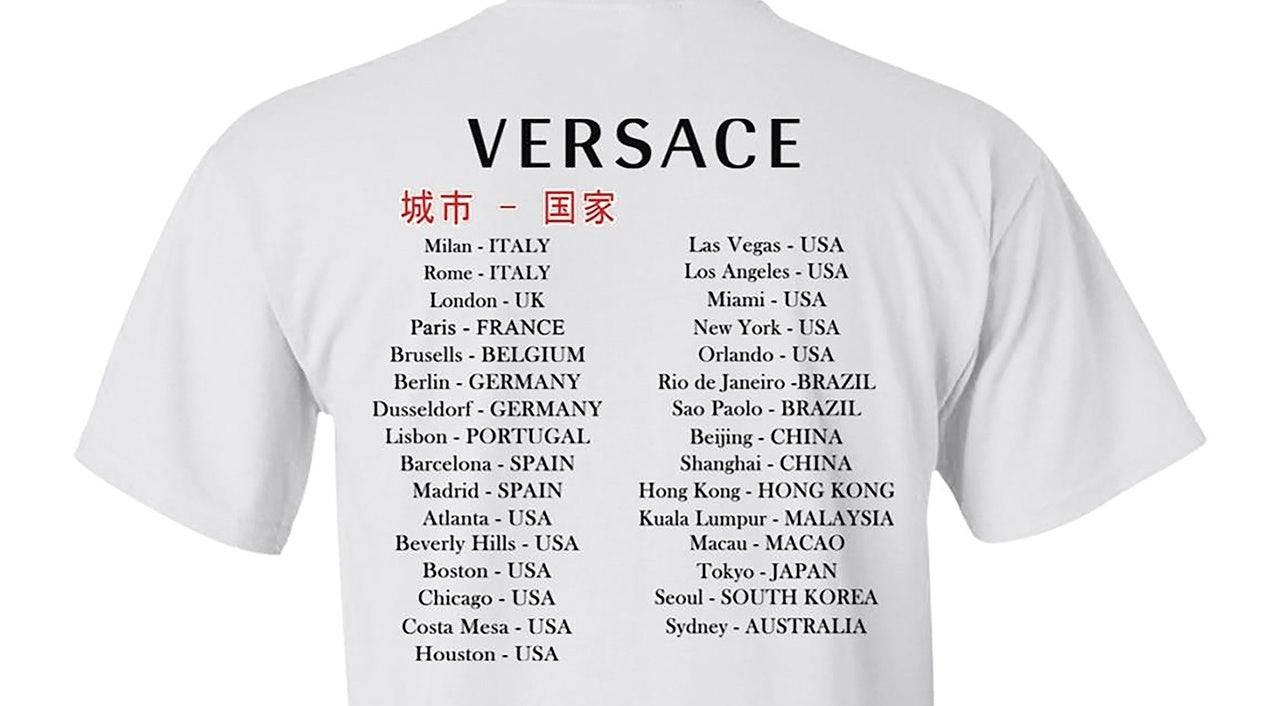Last year, D&G had an infamous moment when an advertising campaign offended Chinese consumers so much that it led to a vast outcry — the resignation of Chinese influencers and brand ambassadors, the cancelation of a multi-million dollar fashion show in Shanghai, and the delisting of the brand by major retailers within a few hours. D&G had to pay a steep price for not paying enough attention to the expectations and tastes of Chinese consumers.
And now it’s Versace turn. One of their T-shirts, retailing for $425 dollars, listed the locations of Versace stores all over the world, but did not link Hong Kong and Macao to China, although both are Special Administrative Regions (SAR) of China. The timing could not have been worse, given the protests in Hong Kong. When Yang Mi, the Chinese brand ambassador of Versace resigned, citing that “Chinese sovereignty and territorial integrity are sacred, inviolable, and brook no division,” a social media outcry against Versace started on platforms like Weibo and WeChat. Versace immediately apologized and stated that it had destroyed all T-shirts immediately — but the damage to the brand had already been done.
We are living in a digital world, where any local brand mistake can have an immediate global impact. Companies are still underestimating it, and eight months after Dolce & Gabbana, most brands have done little or anything to set up processes that prevent such significant mistakes like this from happening. In a previous Jing Daily column from December 5, 2018, I wrote that “the world will know about [negative events in a country] at an even faster pace. One misstep and everything is gone — from brand equity to distribution. And it may never come back.”
Given the stakes, why are some global luxury brands are not taking the lessons seriously enough? Why are companies underestimating Chinese consumers consistently? I have the opportunity to speak with a lot of local brand leadership teams in China. What I hear frequently is a frustration that decisions are made from too far away.
Typically, the global headquarters of luxury companies are responsible for all brand content. From the portfolio to product details to communication. There is, however, a major pitfall in this approach: Local needs and requirements are often not taken enough into consideration. And in many cases, there is a lack of cultural sensitivity.
The disastrous side effect of making a decision too far away — when local cultural details are not considered — is that the brand can be damaged instantly, especially in the digital age. The second shortcoming of this global approach is that communication content is often not relevant for every local market. Given this, more local thinking is needed — and this has to start in the global headquarters. China is too big, too sophisticated, and too distinct to simply apply a one-size-fits-all approach. As such, here are three recommendations I pass along to every global brand operating in China:
First, conduct a thorough brand audit which has to include a rigorous social-media based consumer consent and sentiment assessment as well as a consumer-data-driven competitive analysis. Those advanced consumer insight studies are indispensable. AI and machine learning-based technology can analyze social media and blog conversations in real-time. Any change can be detected before it is too late, actions can be taken swiftly, managerial precision increases drastically.
Second, companies need to validate their processes. What should be global, what needs to be local? Do we have the right managers that can combine global expertise with local sensitivity? This is a weak point for many companies. If China is seen just as a significant market like all others, brands will struggle there.
Third, brand equity thinking has to be in the center of all actions. Many managers tell me that this is what they do already. When I ask how much time, resources, and budget are invested in the brand versus the products, almost all admit that most internal time and money is allocated towards product development. In luxury, this is not enough. Brand needs to be defined along all touch-points, with no detail of the consumer journey left unplanned. The brand is the origin of value creation. Luxury brands can only survive if they deliver extreme value consistently and flawlessly.
D&G was a warning for all other luxury brands. Nothing had happened since then. Until now, as Versace tapped into the same trap. It is time for luxury brands to wake up, audit the status of their brands, validate the quality and fit of their local staff, and take decisive action. This is yet another painful example that to sell globally, brands need to think local.
Daniel Langer is CEO of the luxury, lifestyle, and consumer brand strategy firm Équité. He consults some of the leading luxury brands in the world, is the author of several luxury management books, serves as a regular keynote speaker, and holds management seminars in Europe, the USA, and Asia. Follow @drlanger

